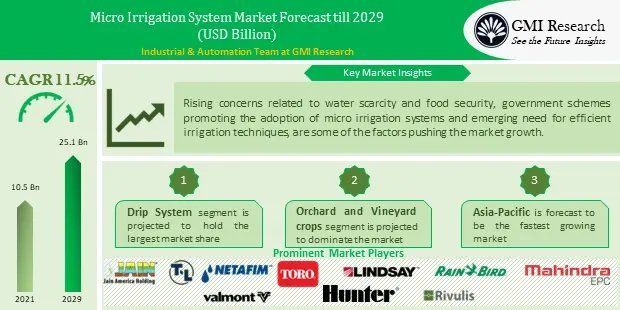What different types of micro-irrigation systems are accessible in the micro-irrigation systems market?
micro-irrigation systems market

Micro-irrigation systems are beneficial for plant growth in activities like agriculture, gardening landscaping, and horticulture, aim to develop water effectiveness, and assist conservation efforts. The term ‘micro-irrigation’ includes different terminologies like localized, low flow, trickle irrigation, and low volume. In the micro-irrigation systems market, there is a rise in investment by market players to develop the workings of micro-irrigation systems.
Working of Micro-Irrigation Systems
Micro-irrigation systems use small openings, often called emitters, to release water in minimal quantities. The significant benefits of this method include promoting soil water absorption, decreasing wasteful evaporation, and delivering water precisely where it’s most required nourishing the plants’ root systems without benefitting weeds.
Today’s Technology Built-in Micro Irrigation Systems
Many irrigation systems include filtering components like pre-filters, sand separators, and screen filters. The filtration level depends on the size of the emitters in the system and the water quality. Some systems feature built-in pressure regulations to balance pressure for the required flow strength. These systems may also integrate automatic delivery software linked to timers, diverting water to different areas at scheduled times. More advanced systems incorporate sensors measuring soil moisture, with the capability to adjust or shut down irrigation based on rainfall. Some even include weather stations. All this technology aims to monitor soil and weather conditions, allowing micro-irrigation systems to self-regulate and deliver the optimal amount of water regardless of prevailing circumstances.
Different Types of Micro-Irrigation Systems
- Drip Irrigation Systems: The design of this micro-irrigation system prioritizes water and nutrient effectiveness by delivering droplets of water that slowly penetrate the root systems of plants. This approach extensively reduces wastage loss through evaporation.
- Subsurface Drip-Irrigation Systems: Sub-surface drip irrigation systems depend on delivery pipes and emitters installed between 12 and 18 inches below the soil’s surface, further decreasing evaporation loss.
- Micro-Spray Irrigation Systems: Micro-spray irrigation systems utilize emitters to release a fine spray or mist of water, with the emitters installed just above the soil’s surface. Due to the mist distribution, these systems are suitable for irrigating larger land locations. However, they tend to be more pricey to install, making them more common in smart projects.
- Bubbler Micro-Irrigation Systems: This type of micro-organization system is typically installed in areas where crops have high water demands. It carries water through fountains and small streams, usually wasting water at a rate of about 230 liters an hour.
Conditions that Demand the Usage of Micro-Irrigation Systems
Micro-irrigation systems are incredibly versatile and find applications in different project sizes and types. Drip irrigation systems, in particular are commonly used in-
- Production-sized greenhouse installation
- Farms
- Home Gardens
These systems offer significant benefits in regions where crops like bananas, courgettes, coconuts, strawberries, tomatoes, grapes, and more are grown, especially in areas facing water shortages. In addition, environmentally conscious home gardeners are adopting drip irrigation systems as a means of contributing to water conservation.
Perfect Systems for Chemigation and Fertigation
If you are new to terms like fertigation and chemigation. Let us shed light on what they are and how they perform in combination with advanced micro-irrigation systems.
About Fertigation
Fertigation denotes the approach of blending fertilizers with water and subsequently carrying the mixture to crops and plants through the irrigation system. Fertigation also aids fertilizer demands while simultaneously increasing the quantity of nutrients that plants can absorb.
About Chemigation
Like fertigation, chemigation refers to the application and delivery of crucial chemicals that crops need. Both fertigation and chemigation technologies uniform distribution of essential fertilizers and chemicals, resulting in an effective increase of 35% or more.



